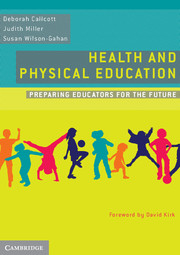Book contents
- Frontmatter
- Foreword
- Contents
- About the authors
- Acknowledgments
- Chapter 1 Introduction
- Chapter 2 The foundation of movement skills
- Chapter 3 Teaching inclusively
- Chapter 4 What all teachers need to know about movement
- Chapter 5 Pedagogy
- Chapter 6 Planning for teaching and learning
- Chapter 7 ICT and general capabilities in the Australian Curriculum
- Chapter 8 Assessment in health and physical education
- Chapter 9 Health education
- Glossary
- Bibliography
- Index
- References
Chapter 7 - ICT and general capabilities in the Australian Curriculum
- Frontmatter
- Foreword
- Contents
- About the authors
- Acknowledgments
- Chapter 1 Introduction
- Chapter 2 The foundation of movement skills
- Chapter 3 Teaching inclusively
- Chapter 4 What all teachers need to know about movement
- Chapter 5 Pedagogy
- Chapter 6 Planning for teaching and learning
- Chapter 7 ICT and general capabilities in the Australian Curriculum
- Chapter 8 Assessment in health and physical education
- Chapter 9 Health education
- Glossary
- Bibliography
- Index
- References
Summary
Learning objectives
By engaging with the text in this chapter, students will be able to:
describe the general capabilities framework in the new Australian Curriculum
apply the elements of the general capabilities framework to the health and physical education learning entitlement
understand how information and communication technology (ICT) can be effectively incorporated into health and physical education teaching and learning practice to support the learning of students with diverse needs
describe social justice principles relevant to access to ICT in terms of gender, ability, social class and ethnicity.
Casey is in her first year of teaching at the local early childhood centre. The director of the centre has called a meeting to discuss the implications of the impending Australian Curriculum. The centre will be required to encourage the children to be literate across a range of areas. Casey recalls her pre-service teacher educator presented many different approaches to teaching health and physical education, but she didn’t see many ways of modelling how to use ICT for the young children in the preschool. In fact, screen time was noted as a factor in the increasing levels of overweight and obesity among children. How can play be accommodated with ICT? Alternatively, how can ICT progress children’s development around the issue of play?
Jennie has been working with Year 4 this year. Although some sporty children are in her class, the gap is widening between the skilled and those disinterested in the game play. Jennie is seeking new ways of teaching physical education to close this gap in students’ attitudes and skill levels and avoid as much as possible the behaviour management challenges arising in her active lessons. How can she incorporate ICT into her teaching to engage the disinterested and poorly skilled? Is that possible or will ‘PE’ be just a ‘busy, happy, fun’ alternative to engaging students in the challenge of skill acquisition?
- Type
- Chapter
- Information
- Health and Physical EducationPreparing Educators for the Future, pp. 121 - 136Publisher: Cambridge University PressPrint publication year: 2012



